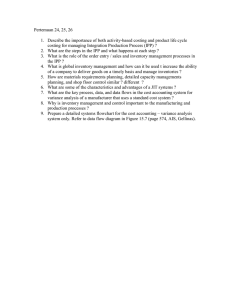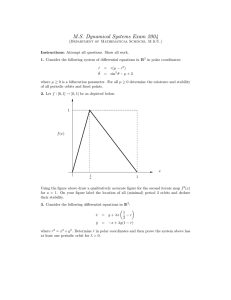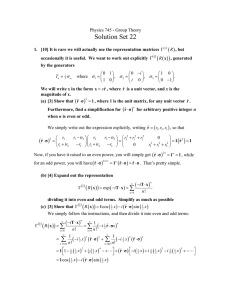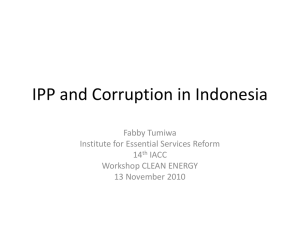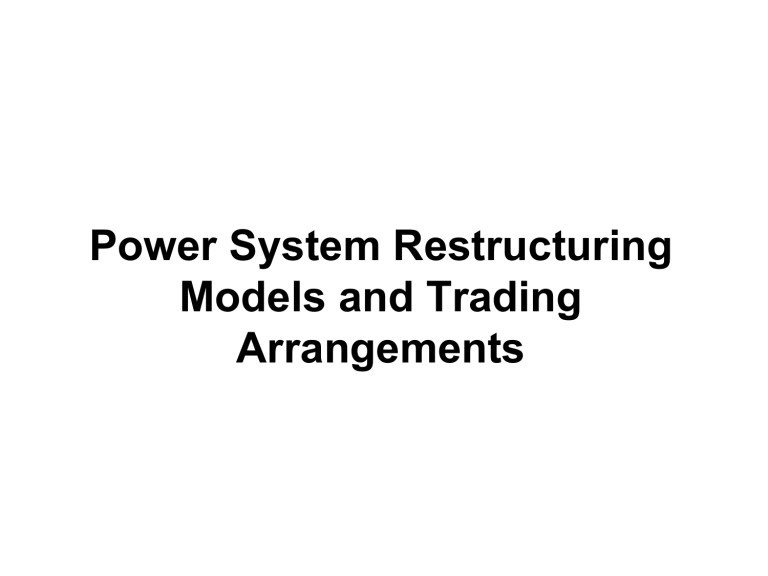
Power System Restructuring Models and Trading Arrangements The electrical energy market Generators Transmission and distribution Consumers Market coordinator (system operator) Information consultants Market traders (suppliers) Energy flows Information or money flows Structural alternatives Characteristic Model 1Monopoly Definition Monopoly at all levels Competing No generators Choice for No retailers? Choice for No final customers Model 2Purchasing agency Competition in generation – single buyer Yes Model 3Wholesale competition Competition in generation and choice for Distcos Yes Model 4Retail competition Competition in generation and choice for final consumers Yes No Yes Yes No No Yes • There is no single model available. • But all can be categorized in 4 basic models • Monopoly – Full vertical integration. – The control and management of generation, transmission and distribution is in single entity. – IPPs are allowed but all power is purchased by utility at pre-specified rate. – There is limited competition in new business such as generation, transmission, and distribution. – No one has choice of supplier. – The service area may cover a whole country, a single region or even a town. Model 1-monopoly (a) Vertical integration (b) Separate retailer/distributor Generator Generator (inter-utility sales through Model 1 Pool) Wholesaler/ Transmitter Wholesaler/ Transmitter Distco Distco Customer Customer Legend Energy sales Energy flows in same company • Single Buyer Model – Also called Purchasing agency. – As its name, a single power purchasing and selling agent, normally the transmission/dispatch company, selling power to wholesalers and large consumers directly connected to the transmission system. – Buyer choose from a number of different generators to encourage competition in generation. – The purchasing agency has monopoly on transmission network and over sales to final consumers. – Commonly used market model following advent of IPPs. – BOO/BOT type projects are very common. Model 2 -Purchasing agent (a) Disaggregated version (Northern Ireland) IPP IPP (b) Integrated version (US under PURPA) IPP IPP Wholesale purchasing agent Own generators Wholesale Purchasing agent Distco Distco Distco Customer Customer Customer Legend Energy sales Energy flows in same company Distco Customer Customer IPP • Wholesale Competition Model – In this model, generators can sell power directly to wholesalers and large customers. – This requires an open access. – This allow Distribution companies (DistCos) to buy directly from the generator and deliver over the network. – Distcos still have monopoly over final consumers. • Retail Competition Model – Generator can sell directly to any consumer at wholesale or retail level. – Requires an open access – Pros: multiple buyers and seller; consumer has choice of supplier; competition in both generation and supply; end consumers more likely to see price signal. – Cons: High transaction costs. Model 3-wholesale competition IPP IPP IPP IPP IPP Transmission wires Wholesale market Distco Customer Distco Distco Distco Customer Customer Customer Legend Energy sales Model 4-retail competition IPP IPP IPP Transmission wires Wholesale market Direct sale Direct sale Retailer IPP Distco/ Retailer Retailer IPP Direct sale Distco/ Retailer Retailer Distribution wires Retail market Customer Customer Customer Legend Energy sales Customer Customer • Components of Restructuring System • Gencos – Gencos are responsible for operating and maintaining generating plant in the generation sector and in most of cases are the owners of the plant. – Open transmission access allows Gencos to access the transmission network without distinction and to compete. • BOT plant operators and contracted IPPs – Build Operate and Transfer (or Build Operate and Own) plant or IPPs who have long term contracts with surrounding, usually national, utilities play an important role in providing additionality of generation in many fast growing systems. – Take-or-pay power purchase agreements are often in force as an economic incentive to investors. • Discos and Retailers – responsibility on the distribution side. – Discos may now be restricted to maintaining the distribution network and providing facilities for electricity delivery – Retailers are separated from Discos and provide electric energy sales to end consumers. – distribution system can be sold off so that investment for reinforcement can be raised and better operating practices implemented. • Transmission Owners (TOs) – owned by government of some utilities. TO must not have any financial interests in the market. – A basic premise of open transmission access is that transmission operators treat all users on a nondiscriminatory basis in respect of access and use of services. – A requirement, therefore, is to designate an independent system operator (ISO) to operate the transmission system. • Independent System Operator (ISO) – The ISO is the supreme entity in the control of the transmission system. – The basic requirement of an ISO is disassociation from all market participants and absence from any financial interest in the generation and distribution business. – However, there is no requirement, in the context of open access, to separate transmission ownership and operation. For example, the National Grid Company (NGC) in England and Wales (E&W) is both the transmission owner and the operator. – The ISO has three objectives: security maintenance, service quality assurance and promotion of economic efficiency and equity. – Types of ISO • Micro • Mini • Normal Competing Generators Ancillary Services Bid Dispatch Power Exchange (PX) Sell Distributors Forecast Micro-ISO Many System Operators (SO) Monitor Control Transmission Systems Competing Generators Bid Ancillary Services Mini ISO Dispatch Power Exchange (PX) System Operator (SO) Sell Monitor Distributors Forecast Control Transmission Facilities Competing Generators Bid Normal ISO Ancillary Services Dispatch Power Exchange (PX) System Operator (SO) Sell Monitor Distributors Forecast Control Transmission Facilities Competing Generators Ancillary Services Bid NGC Dispatch Power Exchange (PX) System Operator (SO) Sell Monitor Distributors Forecast Control Transmission Facilities • Power Exchange (PX) – The PX handles the electric power pool, which provides a forum to match electric energy supply and demand based on bid prices. – receive bids from power producers and customers; – match the bids, decide the market clearing price and prepare scheduling plan; – provide schedules to ISO or transmission system operators; – adjust scheduling plan when the transmission system is congested. – The time horizon of the pool market may range from half an hour to a week or longer. – The most usual is the day-ahead market to facilitate energy trading one day before each operating day. – An hour-ahead market is also useful since it provides additional opportunities for energy trading to redress short term imbalance. – In the E&W system the ISO and PX functions both exist within the NGC. • Scheduling Coordinators (SCs) – Scheduling coordinators aggregate participants in the energy trade and are free to use protocols that may differ from pool rules. – In other words, market participants may enter a SC’s market under the SC’s rules and this could give rise to different market strategies. – Run a forward market in which parties can bid to buy and sell energy; – Develop a preferred schedule for the forward market; – Develop the market clearing price for energy transactions; – Submit the preferred schedule to the ISO and work with the latter to adjust schedules when necessary. – In some markets such as E&W, SCs are not allowed to operate. – In many new situations such as California, SCs are an integral component of the market. Competing Generators Ancillary Services Bid Scheduling Co-ordinators (SC) Brokers Dispatch California PX California ISO Forecast System Operators (SO) Sell Distributors Monitor Control Transmission systems • Broadly speaking, there are three kinds of markets: – Perfectly competitive markets: • There are many suppliers and consumers. The selling or purchasing behavior adopted by one market player will not influence the market price. • Ideally, the market price is at its marginal cost of production. – Oligopoly market • There are a few suppliers. The selling behavior adopted by one supplier has great influence on the market price. • The market price may not necessarily reflect the production cost. There exists market power. – Monopoly market • There is only one supplier. The market price is controlled by the supplier and sometimes with limitations from other organizations such as governments. • The market price generally does not reflect the production cost. • The electricity market has the following features: – Limited suppliers (power producers) – Transmission constraints • isolate consumers from effective reach of many generators • economically isolate submarkets from the competition of suppliers located elsewhere in the network • strategic behavior by the bidders (power suppliers) – Transmission losses • limit consumers to purchase power from some plants which are far from the consumers (because they need to pay the involved losses) • Thus, the electricity market may not be a perfectly competitive market, and is likely an oligopoly market, and there is some potential market power in any form of proposed deregulation structures. • Hence, it appears an important problem on how to identify the market power and then how to limit this power in the electricity market. It may be appropriate to model the electricity market as an oligopoly market. • There are the following main oligopoly market models: • Cournot model – Each supplier bids production quantity, and the market price is a function of the total supply quantity. – A perfect market is an extreme case of Cournot model where the number of suppliers are infinite and the price of the market is constant (not a function of the supply quantity). • Bertrand model – Each supplier bids price rather than quantity at which it is willing to produce. – Lower price will capture the market share and all will have equal shares at equal price. • Supply function Model – Each supplier bids a function linking its price to its supply quantity. – This model is a good compromise between Cournot and Bertrand competition model in a highly decentralized market where the prices of the transactions are not public and where large transactions are likely to be made at different prices from smaller ones. • The oligopoly market model has recently been applied to the electricity market research to investigate the possible oligopoly market price, and to investigate the potential market power. • It should be mentioned the oligopoly market price is different from the location dependent nodal spot price scheme. The main objective of the spot price theory is to send efficient price signals to power suppliers and consumers for siting resources and demand. • A uniform price over the network is likely to provide wrong price signals for siting new power plants. • The main disadvantage of this theory is that it is unable to account for the potential market power that the market players can have in such a framework. • Ownership & Management – – – Direct Government Ownership: (Commercialization) The Government owns and has direct managerial control over the industry. Commercialization happens when the government relenquishes detailed control in favour of autonomy of the enterprise and focus on profitability. This is a change in behavior rather than organization. A Government owned Corporation: (Corporatization) It is the formal and legal move from direct government control to a legal corporation with separate management. This may be a government owned corporation. The ownership of assets and the capital structure need to be determined before this step is taken. A Privately owned Corporation: (Privatization) A third form of ownership is private ownership of the corporation and its assets. Privatization is the move from a Government Corporation to a Privately owned Corporation. The level of government control may depend more on objectives and working of the government than on the organization of the sector.

